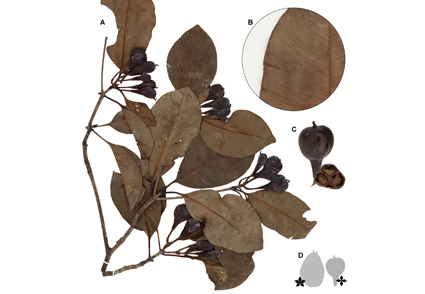Abstract
Herein, we present Tovomita manauara A. Nobre & L. Marinho, a new species of Clusiaceae that is presumably endemic to the Amazonas state, in Brazil. The new species was initially identified as T. caloneura A.C. Sm., which is a morphologically similar and sympatric species. Although the species was based only on vegetative and fruit morphological characteristics, Tovomita manauara can be recognized by the large number of secondary veins (25–36 pairs vs. up to 26 pairs in T. caloneura) and 4-septate, turbinate to napiform fruits (vs. 5-septate and fusiform in T. caloneura). In addition to macromorphology, anatomical characters, such as the secretory canals larger, presence of collenchyma in the petiole, and the absence of druses in the midvein are also helpful for the identification of T. manauara.
References
<p>Cuello, N.L. (1999) Two new distinctively large-leaved species of <em>Tovomita</em> (Clusiaceae) from the Venezuelan and Peruvian Amazon region. <em>Novon </em>9: 150–152. https://doi.org/10.2307/3391790</p>
<p>Cuello, N.L. (2003) A new species of <em>Tovomita </em>(Clusiaceae) from Amazonian Venezuela and Peru. <em>Novon </em>13: 34–36. http://dx.doi.org/10.2307/3393562</p>
<p>Demarchi, L.O., Piedade, M.T.F. & Marinho, L.C. (2021) <em>Tovomita cornuta </em>(Clusiaceae): a new and threatened species from the Amazonian <em>campinaranas </em>revealed by ecological field research. <em>Acta Botanica Brasilica</em> 35 (4): 554–561. https://doi.org/10.1590/0102-33062020abb0483</p>
<p>Ellis, B., Daly, D., Hickey, L.J., Johnson, K.R., Mitchell, J., Wilf, P. & Wing, S.L. (2009) <em>Manual of Leaf Architecture</em>. Cornell University Press, Ithaca, 190 pp.</p>
<p>Engel, J., Molino, J.-F. & Marinho, L.C. (in press) The maximum and the minimum: two new species of <em>Tovomita</em> (Clusiaceae) from the Guyana Shield with an unusual number of stamens. <em>Adansonia</em>.</p>
<p>Engels, M.E. & Marinho, L.C. (2018) Nomenclatural and morphological novelties in <em>Tovomita laurina </em>(Clusiaceae). <em>Phytotaxa </em>334: 91–96. https://doi.org/10.11646/phytotaxa.334.1.16</p>
<p>Esteves, B. (2007) <em>Com os dias contados?</em> Ciência Hoje On-line. Available from: https://cienciahoje.org.br/com-os-dias-contados/ (accessed 17 October 2021)</p>
<p>Hopkins, M.J.G. (2019) Are we close to knowing the plant diversity of the Amazon? <em>Anais da Academia Brasileira de Ciências</em> 91: e20190396. https://doi.org/10.1590/0001-3765201920190396</p>
<p>Johansen, D.A. (1940) <em>Plant microtechnique. </em>McGraw-Hill Book, New York, 503 pp.</p>
<p>Kraus, J.E. & Arduin, M. (1997) <em>Manual básico de métodos em morfologia vegetal</em>. Seropédica, Rio de Janeiro, 198 pp.</p>
<p>Laurance, W.F. & Luizão, R.C.C. (2007) Driving a wedge into the Amazon. <em>Nature</em> 448: 409–410. https://doi.org/10.1038/448409a</p>
<p>Marinho, L.C. (2018) Two new species of <em>Tovomita</em> (Clusiaceae) from Amazonian forest. <em>Brittonia</em> 70: 405–411. https://doi.org/10.1007/s12228-018-9536-2</p>
<p>Marinho, L.C. & Beech, E. (2019) <em>The Red List of Tovomita</em>. Botanic Gardens Conservation International, Richmond, 27 pp.</p>
<p>Marinho, L.C., Fiaschi, P. & Amorim, A.M. (2019) A gold mine: four more new species of <em>Tovomita</em> (Clusiaceae: Clusieae) from Amazonia. <em>Willdenowia</em> 49: 343–350. https://doi.org/10.3372/wi.49.49305</p>
<p>Marinho, L.C., Fiaschi, P., Gahagen, B., Santos, F.A.R. & Amorim, A.M. (2016a) <em>Tovomita</em> (Clusiaceae) from the Brazilian Atlantic Forest: taxonomy and utility of leaf venation characters at the species level. <em>Systematic Botany</em> 41: 758–774. https://doi.org/10.1600/036364416X692406</p>
<p>Marinho, L.C., Fiaschi, P., Santos, F.A.R. & Amorim, A.M. (2016b) Three new species of <em>Tovomita</em> (Clusiaceae) from the Amazon River basin and first record of papillae for <em>Tovomita</em>. <em>Plant Systematics and Evolution</em> 302: 1121–1134. https://doi.org/10.1007/s00606-016-1321-7</p>
<p>Marinho, L.C., Fiaschi, P., Fernandes, M.F., Cai, L., Duan, X., Amorim, A.M. & Davis, C.C. (2021) Phylogenetic relationships of <em>Tovomita</em> (Clusiaceae): carpel number and geographic distribution speak louder than venation pattern. <em>Systematic Botany </em>46: 102–108. https://doi.org/10.1600/036364421X16128061189549</p>
<p>Oliveira, A.A. & Mori, S.A. (1999) A central Amazonian <em>terra firme</em> forest. High tree species richness on poor soils. <em>Biodiversity and Conservation</em> 8: 1219–1244. https://doi.org/10.1023/A:1008908615271</p>
<p>Planchon, J.É. & Triana, J.J. (1860) Mémoire sur la Famille des Guttifères. <em>Annales des Sciences Naturelles, Botanique </em>4: 226–367. [Victor Massonet Fils, Paris]</p>
<p>Radford, A.E., Dickison, W.C., Massey, J.R. & Bell, C.R. (1974) <em>Vascular Plant Systematics. </em>Harper & Row Publishers, New York, 891 pp.</p>
<p>Ribeiro, J.E.L.S., Hopkins, M.J.G., Vicentini, A., Sothers, C.A., Costa, M.A.S., Brito, J.M., Souza, M.A.D., Martins, L.H., Lohmann, L.G., Assunção, P.A., Pereira, E.C., Silva, C.F., Mesquita, M.R. & Procópio, L.C. (1999) <em>Flora da Reserva Ducke. Guia de identificação das plantas vasculares de uma floresta de terra firme na Amazônia Central</em>. INPA-DFID, Manaus, 800 pp.</p>
<p>Smith, A.C. (1939) Notes on a collection of plants from British Guiana. <em>Lloydia</em> 2: 161–218.</p>
<p>Smith, A.C. (1940) A Collection of Flowering Plants from Mount Roraima and Adjacent Venezuela, British Guiana, and Brazil. <em>Bulletin of the Torrey Botanical Club</em> 67: 283–299. https://doi.org/10.2307/2481175</p>
<p>Smith, F.H. & Smith, E.C. (1942) Anatomy of the inferior ovary of <em>Darbya</em>. <em>American Journal of Botany</em> 29: 464–471. https://doi.org/10.1002/j.1537-2197.1942.tb10236.x</p>
<p>Thiers, B. (2022 [continuously updated]) Index Herbariorum: A global directory of public herbaria and associated staff. New York Botanical Garden’s Virtual Herbarium. Available from: http://sweetgum.nybg.org/ih/ (accessed 10 January 2022)</p>
<p>Vesque, J. (1892) <em>Ephamorsis, sive, Materiae ad instruendam Anatomia Systematis Naturalis</em>. Vincennes: Delapierre, 420 pp.</p>
<p>Vesque, J. (1893) Guttiferae. <em>In</em>: De Candolle, A. & De Candolle, C. (eds.) <em>Monographiæ Phanerogamarum 8</em>. Sumptibus G. Masson, Paris, 669 pp.</p>


